As a follow-up post to last week’s discussion of how anyone, anywhere can live a sustainable life, I wanted to share some of the sustainable living things that I am doing here while I’m renting a small house (with terrible solar gain, lol) in a small town in Western Pennsylvania. Through this, I hope to demonstrate that even if you aren’t living the free-range fantasy, there is a lot you can do, both in your own life, and for the greater good in your community. I hope that this post inspires you to share your own ideas!
1. The Walking Lifestyle.

One of the primary lifestyle shifts I made was moving to a place where I could walk to work (hopefully permanently, but we’ll see where life takes me). I think this one shift is so huge, for so many reasons, that it probably offsets everything I’m not able to do in my rental that I was doing at my homestead.
I decided to see how much carbon emissions I saved by walking to campus rather than driving the 36 miles round trip in Michigan. Assuming I go to campus four days a week, 48 weeks of the year, that comes to just under 7000 miles driven per year to get to and fro from work. And there is also my walking to the post office, bank, to pick up food, and more–and the need to drive much less because everything is located conveniently in town. Assuming the lowest estimate, just the work miles, I have saved 2.87 metric tons of carbon this first year in walking rather than driving (you can get your own carbon estimates from Carbon Footprint Calculator). Now maybe that doesn’t seem like a lot, but when you consider that there are severe costs not just to the carbon going in the atmosphere, but also extraction, refining, and transport of fuel that are harder to use an online calculator to figure out, that’s quite a bit. We’ll add to this that I get daily exercise, I no longer have the horrible stress of Detroit Metro area traffic, and I can get a lot more out of my car by not using it as much (reducing the demand for new automobiles!).
And from a spiritual perspective, the walking is amazing. I have tree friends that I visit every day; I use it as a time to do some walking meditation, speak with the spirits, and even a bit of energetic work. I am observing the changing of the seasons in the cracks of the sidewalks and the edges of people’s lawns, each day in the trees. I would be flying by these in a car; and instead, I am slowing down, building in extra time on my walk to take it all in fully, to smell the flowers. It has become something that I look forward to each day rather than dread, and it is now interwoven with my inner spiritual life.
2. Growing Things: Container Gardening, Community Gardening, and Sprouting.
I have been exploring a number of ways to still grow things, which was one of my primary focuses at my old homestead.

Solar gain and container gardening. Each rental or apartment is different, and the main issue to contend with is light. How much full sun do you have? How much space in the sun do you have? This really determines to a large extent what you can grow, especially, what will thrive.
That is my big challenge here, certainly. The rental house I am living in has real challenges with solar gain; no place in the yard gets full sun. I have no south-facing windows! So I have had some challenges with growing things. And yet, I have really embraced container gardening this year. Last year, I discovered that the light is simply not enough to grow most veggies I like (like Kale) so I rented a community garden plot in addition to the containers and am growing veggies I really want to eat there. But, as a permaculture designer, I am focusing instead on how to turn this lack of light into a productive thing. Herbs are doing fine in their pots with the morning sun, so I have rosemary, scented geranium, dill, and a few other herbs in pots; I’ve tucked some herbs also into the “landscaping” on the front of the property (mint, chamomile, new England aster). I have also grown several successive rounds of lettuce and spinach in pots, and am going for a 3rd round now–the part sun is a benefit to the spring/fall crops and keeps them from bolting.
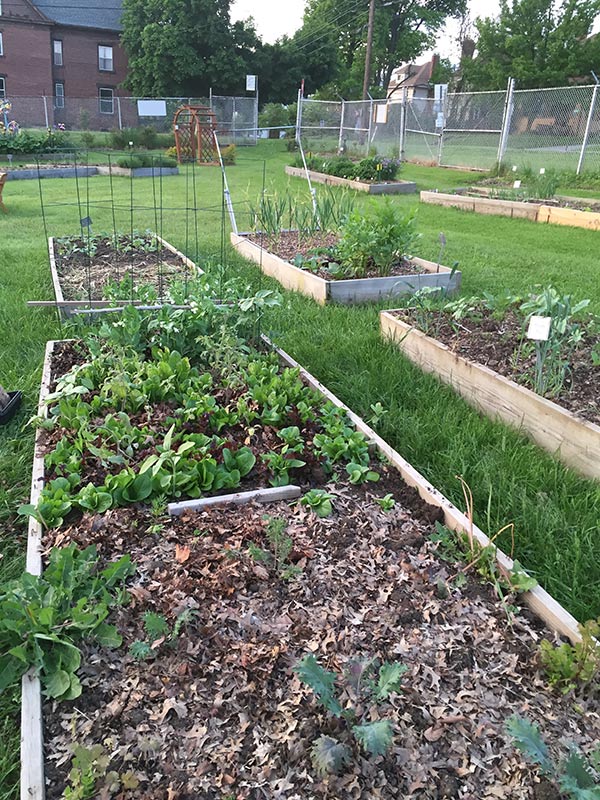
Community Garden. The community garden has been a great place to go when I’m feeling the need to get my hands in the dirt. The way ours is set up here is that in addition to individual plots that anyone can rent for the season (for $25, I believe), there are also many community plots that are shared and that anyone can harvest from. So there is always gardening work to do for people like me who enjoy it! Also, I don’t think you how much you know till you start gardening around other people, lol! I have been having a lot of fun out in the community garden and have a lot of chances to learn and to share. I would recommend it to any renters!
Indoor Growing and Sprouting. I’ve tried a few kinds of indoor growing, but they all required light (for example, growing microgreens over the winter). Since I want to use less, I’m not sure that kind of growth is worth it right now for me. But one carbon-free/energy-free kind of growing I am really enjoying is sprouting. Sprouting doesn’t require much light; it can be done on a counter. It doesn’t take long, and the sprouts are highly nutritious and delightful! I like the alfalfa sprouts the best. You can source seeds that are organic and GMO-free, and support good companies while doing so :).
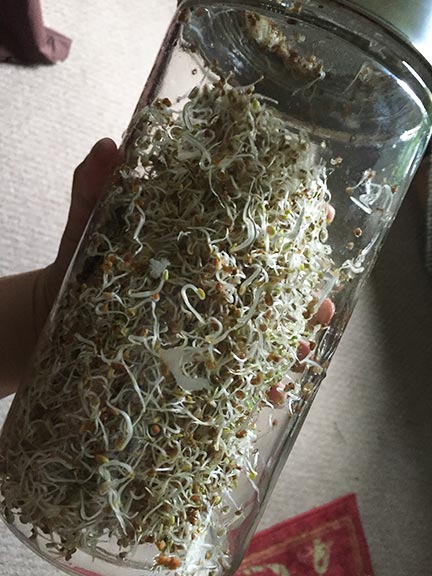
3. Curbing Consumption and “Stuff ” Creep
I’ve written pretty extensively on this topic before, in my disposing of the disposable mindset posts, vermicomposting post, and more. But I want to say a few words here today, especially about consumption and waste, especially in terms of renting and small space living.
Stuff. Knowing that I gave away so much stuff in my life prior to moving has motivated me to keep “stuff creep” (the acquisition of useless stuff you don’t need and clutter) from happening. This is really important in small spaces where you don’t have a lot of spare room! There are a few strategies to do this: One of the ways that I’m managing that is by keeping a box in my living room that is the “give away” box. When it is full, I take it to a local thrift store. The second is that I am never, ever buy anything on impulse. If I am interested in something, I wait a full week before making a decision, and that gives me time to decide if my decision was the correct one. Only then will I purchase it, and only then if I can use it.
Waste. I’ve been, as ever, monitoring plastics and packaging, working to recycle waste, recycle materials, and so on. People know about that and so I don’t have to spell it out here :).
4. Verimcomposting, Outdoor Composting, and Liquid Gold
For renting and small space living, there are actually several good options for composting and reycling of certain kinds of waste.
Vermicomposting. Vermicomposting is something that anyone, regardless of their living circumstances can do. Since I have limited space here, I opted for a smaller model vermicomposter consisting of a few old food-grade buckets that had seen better days. You can read all about how to build a verimcomposter on my blog post.
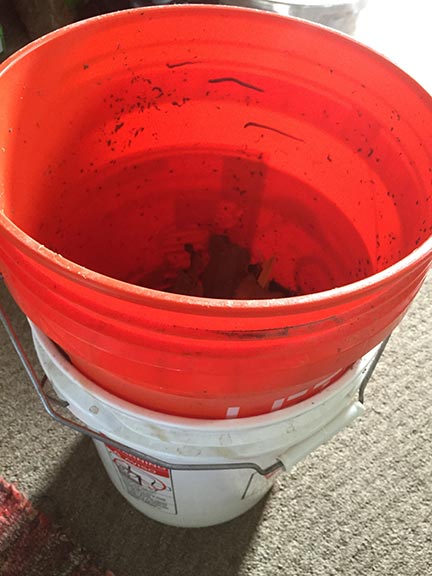

Compost Tumbling. I brought my compost tumbler from my homestead with me to my rental, and boy am I glad that I did! It has really allowed me to make a lot of great compost without any kinds of rodents or large compost piles in the yard that might upset neighbors. The compost tumbler that I have (and that I really like) has two chambers for composting. It claims to be insulated, which I don’t really think matters, lol, but the two chambers of large capacity are super helpful. I switch chambers about every six months, so I just emptied the first chamber and am getting ready to refill it.
Liquid Gold. I would be remiss if I didn’t talk about the effectiveness of liquid gold for watering my plants, which I covered in more detail in this post. My plants are happy and so am I!
5. Life by Candlelight.
I wrote about this a bit in my Winter Solstice post (and you can read that for more depth); I have decided to forgo electric lighting at night and instead live by candlelight. This has profoundly changed my own rhythms, encouraging me to slow down, breathe deeply, and reconnect with the quietude of the dark. I’ve been experimenting with a number of different kinds of lighting and candles to get the most efficiency possible. I gave a lot of clear instructions for sourcing candles, lighting, etc, in my linked post, so I’ll encourage you to read.
One thing I’ll add is that I’ve now been doing this lifestyle for about 8 months. It is truly amazing. I love living by candlelight at night; I sleep better, I feel less stressed and frantic, and I just feel more stable overall. It is amazing how such a small shift makes such a big difference, but it really does.
6. Haybox Cooking
Good friends of mine (two different sets) taught me about the haybox. It is a very simple contraption–you heat something up, and then rather than continuing to use heat (like the oven or stovetop) to cook it, you instead pull it out of the oven and put it in a well-insulated box. This saves on fuel. Here’s a nice introduction to how to build one. A few weeks ago, after finally getting my new dutch oven (!!!!) I started experimenting with the haybox and I really like it! I have a very rudimentary one that is not nearly as nice as the one in the article I linked above, lol, and it is made of a cardboard box with an old blanket as insulation (the hay would obviously be messy). I have found that cooking simple things, like vegetable soup, works well. My first attempt didn’t have everything cooked the whole way through cause I started it in the afternoon (and I should have started it in the morning). I’m still very much experimenting!
7. Thermostat Changes and Air Conditioning
This is a pretty standard thing, but it’s important to mention. Even when renting, you have control over your thermostat and your decisions about whether or not to crank up the AC in the summer or heat in the winter. I have spent a lot of time figuring out how to move air through the house effectively to avoid the AC using fans in windows–this has been great! I also invested in some great wool socks and sweaters and can keep my house a much lower temperature in the winter. Simple things add up :).
8. Supporting Local Farmers with Chemical-Free Growing Practices
So obviously while renting in my solar-gain challenged circumstances, I’m not growing much of my own food these days. However, this has been a wonderful opportunity to get to know my farmers at the farmer’s market and support them! I have found several organic growers that I really like; additionally, I found several offering local pasture-raised meats, cheeses, dairy, and more. Even in a quiet town in the mountains, there are good options available. They aren’t as bountiful or divere as the Detroit Metro Area by any means (which is really like a local food Mecca!) but they are there if you know where to look.
9. Plant Education in the Community
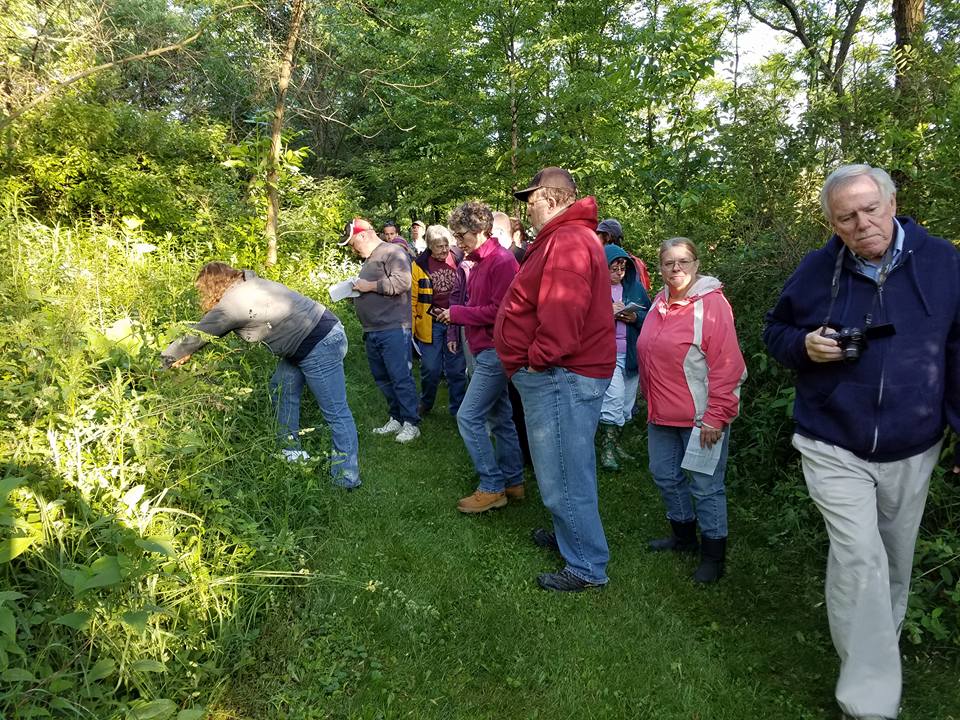
So this is one of the things I am most excited to share. When I got here, I found some people doing some good work with conservation and standard gardening, but not too much else. I decided to go for it, offering my knowledge as a permaculture designer, herbalist, and wild food forager to the community. The response has been really great! I’ll share one story: I began offering plant walks this summer to people who wanted to learn more about the edible and medicinal uses of plants. I see this as part of my work in the world as a druid–helping reconnect people and nature. I decided I didn’t want to earn money for them (it is sacred work, part of my spiritual path) so instead I took a donation for a good cause (and each walk is for a different cause). My first walk was a few weeks ago (my second one is this week) and I had 25 people show up and raised $350 for charity! They were a great bunch and since then, many are posting about their garlic mustard pesto and dandelion greens! I opened the walk with a discussion of dandelion and closed the walk with some tasty treats and a delicious bottle of dandelion wine. It was super exciting!
10. Land Healing, Scattering Seeds, Wildtending
Long-term readers of my blog will have noticed my shift in energy and focus: In moving, since I didn’t have land of my own, I shifted my focus instead on tending the broader land around me. This has been really productive for my own thinking, as well as for the land here, I believe. I have written a lot of posts on this subject in more depth: my post on healing hands, my series on wildtending and refugia and seed balls, my extended series on land healing. Its interesting because I never realized how intently focused my gaze was on that one piece of land till I no longer had it, and it was almost like waking up, looking around, and saying, “ok, now what?!?” I think good things have come of it!
11. The Disposables Problem
I have also worked to tackle the disposables problem by starting to carry with me my own take-out containers, buying in bulk when possible, and eliminating plastics from my life as much as possible. One of the small, yet important, shifts I made was investing in some stainless steel silverware (a spork and pair of chopsticks) that I keep in my purse. Now, if I’m at the Chinese buffet, I don’t need to consume another pair of chopsticks. If I’m at tge campus function and there is disposable silverware, I get my spork out instead. This has equal value as an educational tool as it does to reduce waste :). I have an acquaintance who sells them.
12. Slowing Down
A few of these (walking, candlelight, haybox cooking, local foods) have a united theme: the theme of slowing down. I have been reading a lot more about the slow movements–slow food, slow money, etc. I wouldn’t necessarily say that these things are “slow” in the sense that nothing ever gets accomplished. But they are slowing down to the right speed so that we can more fully and meaningfully live! And that’s good by me!
Other Stuff I’m Excited to Try: I have been looking diligently for a large, used fish tank with the hopes of getting an indoor aquaponics system setup. The fish tank hasn’t yet manifested itself, but I suspect it will when the time is right. I’m quite excited to try this approach! I’m also working on building a solar cooker and experimenting with a lot of different kinds of gas-free cooking, like dutch oven cooking. I’m also, obviously, in search of my next property so the real fun can begin again!
What are you doing in your spaces, great or small! I would love to hear from you :).
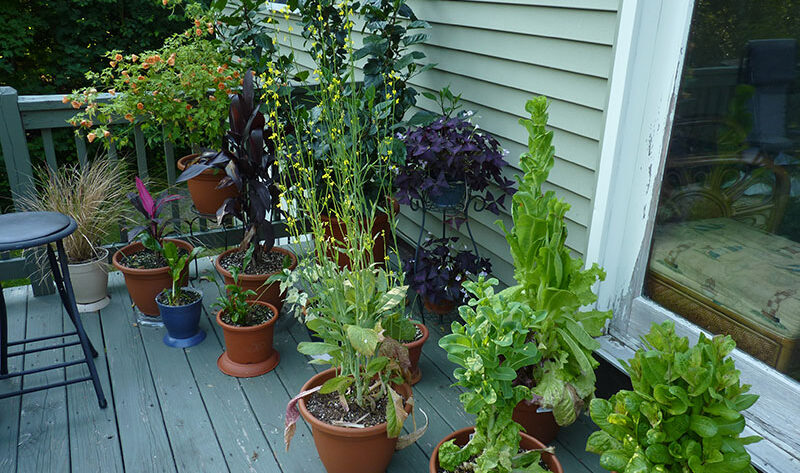


Lovely post! So many rich, useful ideas!
Thank you!
Excellent article. One thing I’d like to add is private gardening for an elderly householder. I did this before I owned a home. I cleaned up the yard and planted fruits and vegetables. It can also help them stay in their home longer.
Even large apartment complexes might let you use some space for gardening. In this case, I planted stealth foods that were less obviously vegetable to keep it attractive… edible landscaping. With the older person, I shared produce as rent. It was someplace I walked by all the time and had several chats before offering.
That’s perfect! When I was living in a condo, I also planted stealth foods. Things that they wouldn’t know are foods–Nasturtium, Love in the Mist, etc :). It was great!
I live in a small apartment is a senior residence, BUT!! the property is surrounded on three sides by protected forest. We see lots of wildlife all the time. Owls and hawks have nested on this site. I have a community garden space there. I grow must of my vegetables and herbs. I take all my vegetable scraps out to the forest for regeneration as we have no composting available. We have a big recycling container that we fill every week. For the last 3 years I have been tending to a young birch tree that grows by the parking lot. It was being strangled by bittersweet
and poison ivy. I have cut back all of them and the tree is thriving now. I have the maintenance crew help me keep the vines away from the birch now. I think you can choose how you want to live no matter where you live. It’s your choice.
This is wonderful work! Thank you for sharing! I have been saving some sassafras trees in the woods from bittersweet as well 🙂
Reblogged this on ravenhawks' magazine and commented:
Great Post, thank you.
You are most welcome! Thanks for the reblog!
Reblogged this on Rattiesforeverworldpresscom.
This is wonderful, thank you! I’m also a renter and have struggled with finding ways to live more sustainably, but your suggestions are great! I’ve got a compost heap, and just this weekend repurposed some old buckets to grow herbs and lettuces, and I’m off to the garden centre next weekend to get some big pots for veggies.
One of my favourite things to do in terms of connecting to nature is another simple one: feeding garden birds. Since getting a bird feeder, and watching who comes to visit (including a local woodpecker!), my enjoyment of my otherwise fairly blank rented lawn “garden” has improved so much.
It sounds like you are making a great difference, The birdfeeder is a great idea! Mine has been overrun by squirrels, lol!
Mine too, but we have cool black squirrels here which are fun to watch!
I had those in Michigan, but I haven’t seen any here in PA 😛
thank you for this post – I found it really inspiring. I don’t have a garden/yard where I am and really would like one and your post gave me some excellent food for thought for options and possibilities when I finally move. I much prefer candles to harsh electric lights. We have energy saving light bulbs which I find uncomfortable – so I guess they really are energy saving seeing as I keep them switched off! 🙂 I love your plant walks.
Jillian, there are things you can certainly do now :). I am glad you like the plant walks–will be doing another plant walk tomorrow! 🙂
Hi Dana,
That is a good article. I began to read by candlelight after your Winter Solstice article and find it helps me get to sleep. I am looking forward to trying some, “Druid Nights,” when the winter comes. My husband will resist bitterly and then probably decide we should do without electricity every night.
We started living together eighteen years ago in a little apartment with a balcony and the balcony gradually filled up with pots of flowers and herbs. We used to get hummingbirds coming in for a drink. I wanted a plot in a community garden but could only have it if I agreed to run the garden and that turned out to be great fun. I homesteaded that apartment. We baked our own bread, canned fruit, made jams, made and bottled wine, hunted mushrooms and scrumped apples and blackberries. The lessons I learned there sure helped me when we were able to move to the country and have a big garden and orchard.
All the things we did in that first apartment helped us save money in fun ways. We paid off all our debts and saved $20,000 Canadian in two years and were able to put the $20,000 as a downpayment on a nice little rural property. We rented that out for the next 6 years until we were able to retire here on a small military pension. It took us eight years to pay off the 25-year mortgauge.
Yours under the red cedar,
Max
Hi Max! Thanks for sharing your story about how you came to your land! I love how you talk about the journey, and homesteading the apartment! This is a hopeful story for many on this path 🙂
Reblogged this on Laura Bruno's Blog and commented:
Here’s another excellent and timely post from Dana. In addition to the things she’s mentioned, I would add that I love our SunOven and my WonderOven (kind of similar in idea to the hay box). Our rental yard is now unbelievably planted and productive, but back in Madison, we had the same light issue and had quite the container garden to augment our little strip of garden.
I’ve also realized that whenever David and I do move to a much, much more compatible area for us, I will take all this knowledge I’ve learned here and tailor it to a smaller scale of highly productive favorites that fit the new site. I love my garden. Besides David, it’s literally my best friend in Goshen and what keeps me sane in Northern Indiana; however, living in a place with vegan restaurants, more compatible people, and natural beauty besides that which I’ve planted myself, I won’t want to spend so much time in the yard.
As Gurumukh says, “We must start wherever we are, because if you don’t start somewhere, then you’ll be nowhere.” Live and learn, adapt and thrive. Determining what’s most doable for you in your own situation is key.
https://www.youtube.com/watch?v=NnzIg3XdcjY
Gesendet: Sonntag, 03. Juli 2016 um 14:49 Uhr Von: "The Druids Garden" <comment-reply@wordpress.com> An: peter.riefenthaler@gmx.at Betreff: [New post] Sustainable Living in a Rental House: Options, Ideas, and More
Dana posted: "As a follow-up post to last week's discussion of how anyone, anywhere can live a sustainable life , I wanted to share some of the sustainable living things that I am doing here while I'm renting a small house (with terrible solar gain, lol) in a small tow"
I love the spork idea! I will get one. Do you find that candelight is enough to read by? I enjoy low lighting in the evening, but reading is one of my primary activities and I don’t think candlelight would be enough for my eyes anymore. Also, a further note on home cooling without AC, which you’ve probably thought of but I’ll put it out anyway–if you have an attic with windows, open them, plus your attic access, to vent heat out through the top of the house. (Bonus for my cat, he loves going up in the attic.)
I can only read by about 4 candles or one of the candle lanterns. The candle lanterns, that reflect the candlelight, are really incredible! An oil lamp also works. Or a head lamp, lol!
That’s a good point about the attic with windows. I don’t have one here!